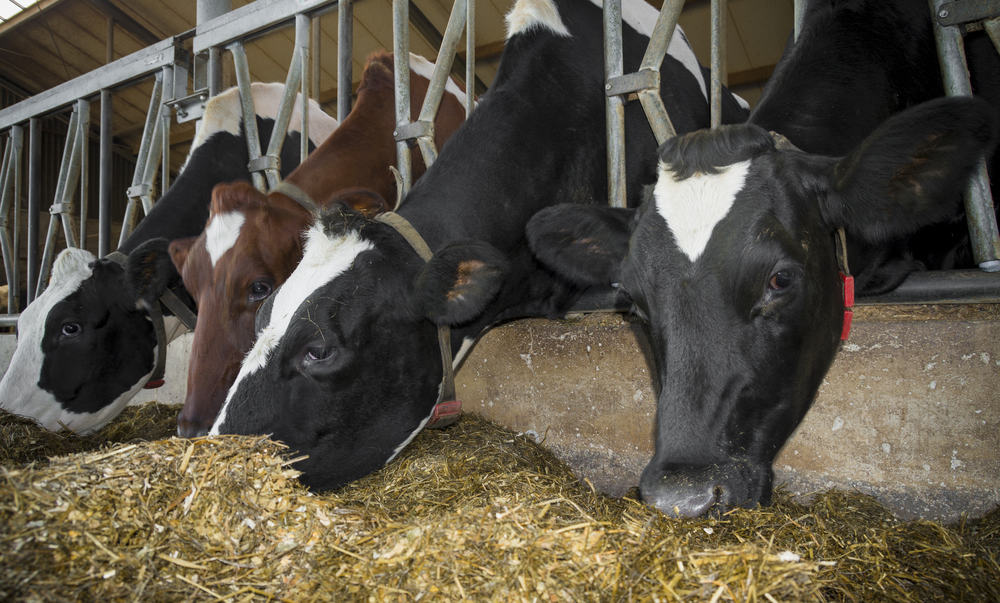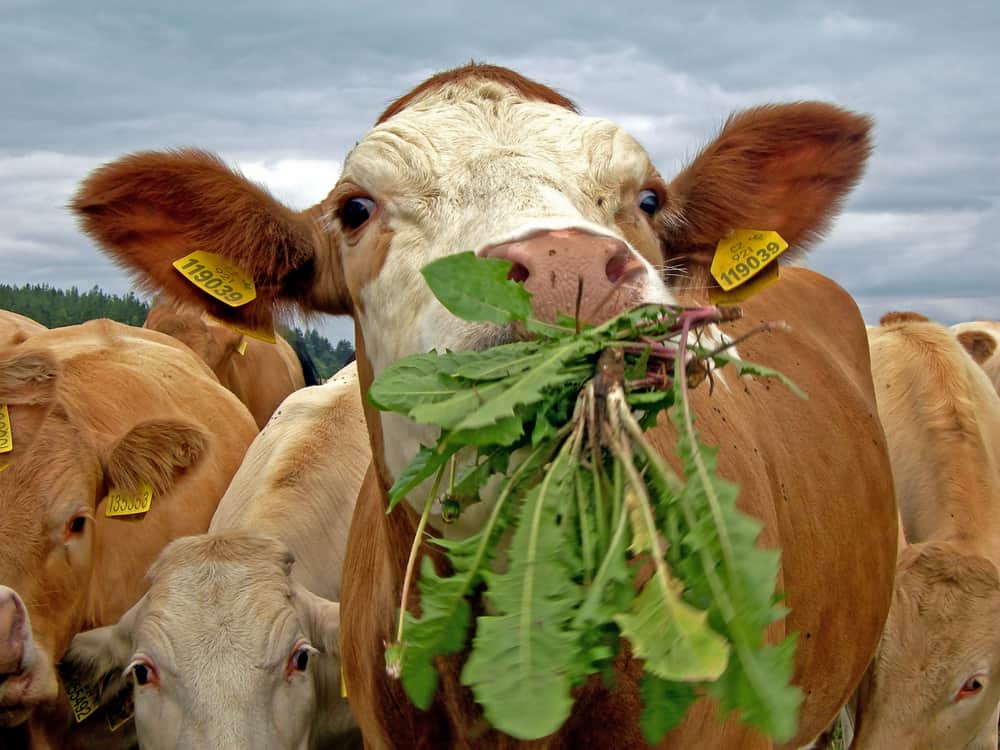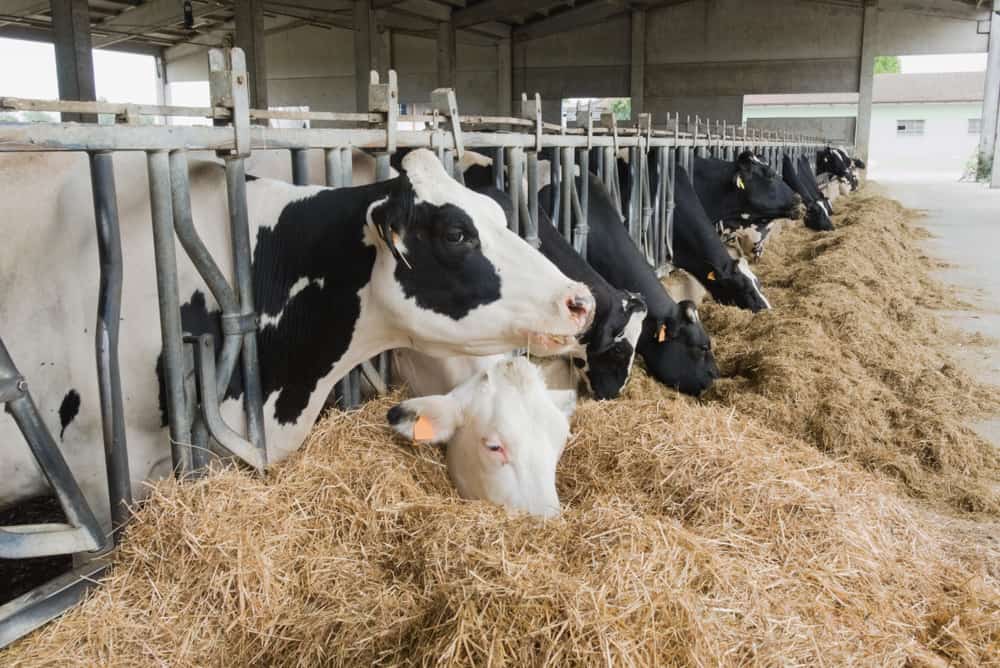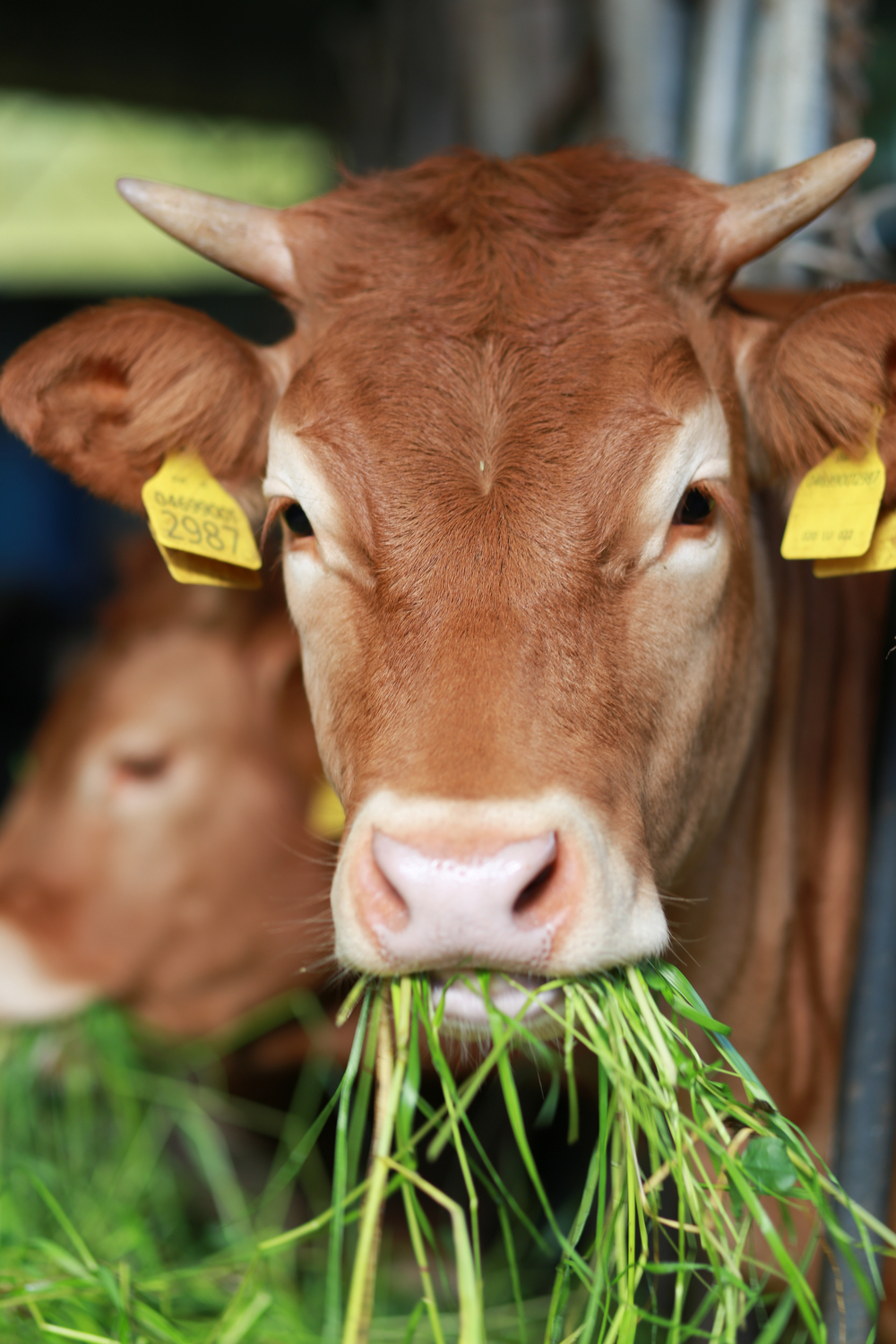Why is it cows don’t understand what you say? This is because it goes in one ear and comes out the udder! People primarily keep cows for beef and milk production.
We all know they eat grass, but besides that, what do cows like to eat? Let’s find out, shall we?
Cows Habits And Biology
Cows are diurnal mammals, meaning that they are active both day and night. They spend a better part of the day grazing and spend their nights chewing and digesting foods consumed in the daytime. This behavior is known as chewing cud.
Domesticated cows sleep for an average of about four hours a day.
Cows have fewer teeth than other animals to assist them in feeding. They lack incisors on their upper jaw. Instead, they have a tough, leathery pad. In addition, they have an immovable upper lip in comparison to goats and sheep. Due to their unique dental formula, cows use their tongues to grasp a chunk of grass and bite it off.
They use their molars, located at the back of their mouths, to shred grass into small pieces for easy digestion.
These mammals are social and live in herds. Size, age, and gender play a crucial role in determining the leader of the herd. Male cows are called bulls, whereas females are typically known as cows and their offspring calves.
Cows rarely fight. Instead, they maintain bonds between one another and use mock fights when settling disputes. In the pecking order, the less dominant cow licks the hide of the more dominant cow.
Horns of bulls aid in mate selection, where those with more prominent horns have better chances of wooing their female counterparts. Horned cattle typically distance themselves from others and rarely engage in physical interactions compared to those without horns. This behavior helps promote stable relationships.
In natural circumstances, calves stay with their mothers for eight to eleven months until they stop breastfeeding.
When grazing, cows adjust their behavior with the availability of food. In areas containing generous amounts of food, they increase their food intake compared to areas where food is scarce.
Cattle steer clear of grazing areas contaminated by other cattle more than they avoid areas contaminated by sheep or rabbit droppings.
What Do Cows Eat?
Cows are herbivores that feed mainly on vegetation. When cows feed, they only chew their food for a little while before swallowing. The food then moves to the rumen, which is the largest portion of the stomach.
Here millions of microorganisms help the animal get the nutrients it needs from the food. When their rumen reaches full capacity, cows find a cozy place to lie down and chew their cud.
Do cows eat anything other than grass? Yes. Cows don’t acquire all the nutrients they require from simply feeding on a pasture. Different food materials play a crucial role in their health and development.
Let’s have a look at what cattle eat:
- Hay –the variety of hay you feed your cattle depends on your location. The most common types include Bermuda grass, Timothy grass, and orchard grass.
Nutritional and physical factors vary depending on the type of hay you use. A feeder should be used when giving cows hay as feeding them in an open space may result in wastage.
- Pasture – cows enjoy fresh grass. If you have an ample supply of grass to support your cows for a year, you’ll be able to save more money than buying hay.
Cattle will devour the rich parts of the pasture first, generally choosing the softer, immature leaves before the mature plants.
As previously mentioned, cows will avoid feeding on grass that other cattle have pooped on. Due to this, the pasture grazed on won’t be uniform. Some sections will be more grazed on than others.
- Bananas –are rich in vitamin B6, starch, and sugars. They are also high in potassium that helps strengthen cow’s bones.
- Alfalfa cubes – should be fed to female cows only as it assists with milk production.
- Watermelon serves as a healthy treat as they are high in sugars and vitamins, therefore acting as suitable supplements for cows.
- Oranges – are a rich source of roughage and vitamins for cows. They also contain antimicrobials that aid in protecting the cows from disease-causing bacteria.
- Pumpkins –are healthy treats for cows. However, don’t feed cattle pumpkins that are rotting.
- Apples –are rich in various nutrients and are healthy for cows. That said, they should be given in moderation as too much can cause cattle stomachs to bloat.
- Pears –are rich in energy, and cows find it delicious.
- Carrots – are palatable (tasty) to cows and are also a good energy source for cattle.
- Oats –act as an excellent feed for cattle. They are high in fiber and assist in digestion.
- Cactus –is rich in highly soluble carbohydrates, calcium, potassium, and vitamin A. It also acts as a good water source for cows brought up in harsh environments.
- Corn –acts as suitable cattle feed. However, it has low protein content.
- Flax/linseed – is healthy, especially for dairy cattle. It contains protein and is also an excellent source of energy.
Foods To Avoid Feeding Cows
Like other animals, cows also have foods that are toxic to them. Aim to keep such foods out of the cattle’s living spaces. For cows, the list is long. They include:
- Mustards –such as wild cabbage, turnips, kale, Indian mustard, wild mustard, etc
- Ponderosa –young shoots, needles, and buds.
- Nightshades –such as datura are distasteful to cows and are usually accidentally ingested. When consumed in large amounts, symptoms include rough coat, emaciation (become very thin/feeble), constipation, and if untreated, it can lead to death.
- Algae –symptoms of poisoning appear 20 minutes after ingestion, and they include difficulty in breathing, weakness, convulsions, and ultimately death.
- Butterfly milkweed –is typically harmless to livestock unless consumed in massive amounts.
- Pigweed – causes kidney complications.
- Onions and chives –cause anemia in many animals, including cattle.
- Yew –all parts of the plant are poisonous to the plant except the red fleshy parts. It causes heart complications in cattle which eventually leads to death.
- Oak –acorn, and leaves are toxic to cows.
- Avocado –eating the leaves, stem, bark, skin, or seed causes heart complications in cattle.
- Potatoes –are resistant to digestion in ruminants. When given in large amounts, it may result in low produce and poor performance by cattle.
- Mayapple –causes severe digestive problems, pain, and nervousness. Eventually, the animal will die from convulsions.
- Buttercups –causes sours in the mouth of cows and gastrointestinal (concerning the stomach and intestines) complications and eventually leads to death through convulsions.
- Arrowgrass –when eaten in large amounts, it causes respiratory failure and kills the animal.
- Marijuana –is healthy for dairy cows but only when fed in small amounts. Excessive intake may lead to digestive complications.
- Foxglove –all parts of the plant are poisonous, especially the leaves. Symptoms of ingestion include gastrointestinal irritation, nausea, diarrhea, and contracted pupils.
- Elderberry –when consumed, it causes breathing problems, then unconsciousness, and finally death.
- Water Hemlock –is very poisonous both to human beings and livestock. It causes violent convulsions that ultimately lead to death.
- Poison Hemlock –consuming small amounts of the green, dried plant is toxic to humans and livestock. It causes death.
- Lupine –small amounts are highly poisonous. Calves will be born deformed, for example, with crooked legs.
- Red maple–green leaves of the tree are edible, but the withered leaves are toxic and can lead to death within twenty-four hours of consumption.
- Black cherry –withered leaves from the tree are highly poisonous and can quickly kill livestock.
Tips To Feeding Cows
Feeding cattle is not as easy as some people perceive it to be. You don’t just put hay in front of them and expect them to eat. It takes way more than that.
The reality is you should be aware of what type of feed is available, how you should feed your cattle, and how the food will affect your cattle’s productivity and health.
Keeping cattle takes a lot of knowledge, time, and finances. Are you ready to get to work? If so, here are some pointers to consider:
- Figure how much food your cattle require depending on their breed. The breed of your cattle is vital in determining their nutritional needs. Some breeds require more of certain nutrients than others.
- Change or modify your cattle’s food based on environmental conditions. Consider factors such as the condition of pasture, what crops grow in your region, and how cold it gets at night.
- Select the best feed that meets the nutritional needs of your cattle. There is a variation of options when it comes to choosing feed for your cattle. Choose yours based on the dietary needs of your cows and what’s available in your area.
- Raise the amount of feed for nursing or pregnant cows. These cows require more minerals, nutrients, vitamins, and water to develop their babies or produce milk.
- Work with a vet to pick the proper rations for your cattle. Professional help from a vet or a cattle specialist always comes in handy as it’s difficult to ration feed. A vet or cattle specialist will guide you on how much your cows should feed and what the nutritional components of the food should be.
By following these simple guidelines, your cattle will grow and remain healthy.
Summary
Caring for and feeding cows requires a lot of time and effort. But if you are willing to get your hands dirty, the fruits of your labor shall be sweet –literally.
Knowing what cows eat plays a vital role in their care. Be sure to do your research before choosing what breed of cattle to keep.



